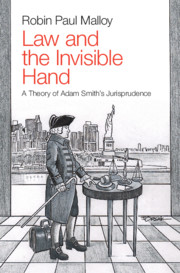Book contents
- Law and the Invisible Hand
- Law and the Invisible Hand
- Copyright page
- Dedication
- Contents
- About the Cover
- Figures
- About the Author
- Preface
- Acknowledgments
- Guide to Citations by Adam Smith
- 1 Introduction
- 2 Setting the Stage
- 3 Social Organization in the Informal Realm
- 4 Social Organization in the Formal Realm
- 5 Integrating the Informal and Formal in Smith’s Theory
- 6 The Spectator View
- 7 Judgment and Justice
- 8 The Sentiment of Common Interest
- 9 The Impartial Spectator, Homo economicus, and Homo identicus
- 10 Understanding the Four Stages of Progress
- 11 Adam Smith in American Law
- 12 Parting Thoughts
- Bibliography
- Index
6 - The Spectator View
Published online by Cambridge University Press: 27 September 2021
- Law and the Invisible Hand
- Law and the Invisible Hand
- Copyright page
- Dedication
- Contents
- About the Cover
- Figures
- About the Author
- Preface
- Acknowledgments
- Guide to Citations by Adam Smith
- 1 Introduction
- 2 Setting the Stage
- 3 Social Organization in the Informal Realm
- 4 Social Organization in the Formal Realm
- 5 Integrating the Informal and Formal in Smith’s Theory
- 6 The Spectator View
- 7 Judgment and Justice
- 8 The Sentiment of Common Interest
- 9 The Impartial Spectator, Homo economicus, and Homo identicus
- 10 Understanding the Four Stages of Progress
- 11 Adam Smith in American Law
- 12 Parting Thoughts
- Bibliography
- Index
Summary
Adam Smith’s theory of jurisprudence revolved around the use of his metaphorical device of the impartial spectator. The impartial spectator represented a naturally occurring force within human beings – a force of reasoning, judgment, and justice. The impartial spectator was not a decision-maker acting behind a hypothetical veil of ignorance; the spectator was a disinterested third-party observer capable of sympathizing with people in a given situation.1 In Smith’s theory, the impartial spectator was positioned as a real person who made judgments by drawing on experience and referencing this experience to the core shared values and moral sentiments of the community.2 The goal of these judgments was to make fair, reasonable, and rational decisions that would be understood as just.
- Type
- Chapter
- Information
- Law and the Invisible HandA Theory of Adam Smith's Jurisprudence, pp. 65 - 76Publisher: Cambridge University PressPrint publication year: 2021

